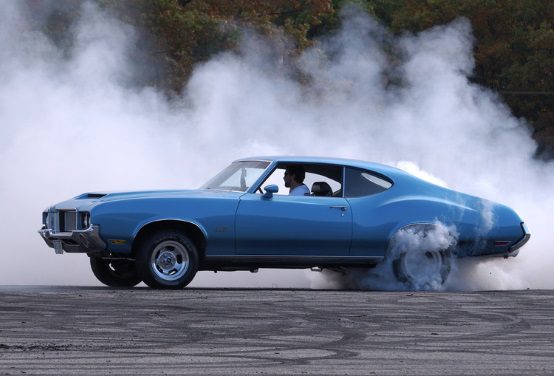American Idyll

Every Labor Day weekend means memories of another “Burn Out” at the Bean Fest in Fairgrove, a rural Midwest town, population 621, halfway up Michigan’s Thumb.
The Burn Out is a motoring contest that tests a peeler’s (the driver’s) skill at burning rubber while commandeering a vehicle, often equipped with new tires. They stage the Burn Out at the Motor Sports Park on the south side of Fairgrove, a quarter-mile from the old concrete slab near the crossroads where I saw my first peelers, a group of townies, at the end of the 20th century. That old slab produced three-foot piles of galvanized rubber—washed away by the local volunteer fire department’s water hoses—and 50-foot plumes of smoke that soared above tree-lined Main Street before drifting across the dry bean fields and merging with a crimson and ocher sky.
The Thumb was the site of one of Richard M. Nixon’s last political stands, undertaken in April 1974 as impeachment loomed. “We are going to do everything we can,” Nixon told a crowd, estimated at 5,000, in nearby Bad Axe, “to increase the supply of fertilizer in this area so that the farmers can sell more of those beans—what is it, $48? Well, that is not bad.”
Nixon’s sojourn in the Thumb is a reminder that Burn Out isn’t a marijuana-fragrant party for baby-boom relics from the Woodstock era. It’s a small-town celebration of two great American manufacturing industries: motor vehicles and tires.
“It’s bigger than Ford and Firestone,” one local explained at my first Burn Out. The contestants are Americans driving domestic vehicles exuding horsepower not fuel efficiency. This competition is fought with domestics like a ’34 Ford, a ’67 Chevy, a customized Econoliner, and an old GM painted all yellow, even the tires. New tires are a big expense, but they peel cleaner. “He has $23,000 into that truck,” the fiancée of one driver proudly explained.
The aim is to leave the longest streak of burnt rubber on the pavement once the driver, a townie usually in his early-to-late 20s, hard shifts from neutral or park to drive. The prize is bragging rights in this corner of the Thumb until next year. The skill is maintaining control of the vehicle in the split-second before shifting. Vehicles occasionally bounce and buckle on the pavement, leaving more than one spectator gripping his bleacher seat. This is NASCAR nation on burnt rubber, with all of its cultural divides.
“We were breathing it in,” a Thumb rider recalled of her experience sitting in her future son-in-law’s pickup during a Burn Out. “I couldn’t see him in the haze although he was sitting next to me. It was so thick, the smoke, that you couldn’t see anything. I swatted the air, so that I could see, but the smoke was so thick it didn’t matter.” Yes, she would ride again.
These Burn Outs are a foreign ritual to urban outsiders. “The mentality of people who can sit here and watch this for hours, get themselves all stinky with smoke and burnt rubber, and yet they still sit there because everyone else is,” complains a visitor from a Detroit suburb. “It was interesting for a few vehicles, but that was about it for me.” A few spectators remark on issues far removed from skid marks. One young woman, wearing a black shirt, skirt, and cowboy boots, with two young children, tells a girlfriend she disapproves of another friend’s behavior. “You never went up to guys like what Cassandra was doing. You stood around and waited for one of the guys to notice you. Back then, more guys took the initiative.”
 There are no dry counties in Michigan, and disputes reemerge later in the beer tent, where the truth is oftentimes revealed before the witching hour. A lucky few might even meet a farmer who knows how to make dandelion wine without Kurt Vonnegut.
There are no dry counties in Michigan, and disputes reemerge later in the beer tent, where the truth is oftentimes revealed before the witching hour. A lucky few might even meet a farmer who knows how to make dandelion wine without Kurt Vonnegut.
The rural Midwest is known for its festivals honoring agricultural products and family farms. Here in the Thumb these include Sebewaing (sugar), Munger (the potato), Bayport (fish sandwich), and, of course, Fairgrove (the bean). If it’s beans you’re looking for, the best place to buy them is at the grain elevator in nearby Akron (pop. 461). Around here the Ohio city is known as “the other Akron.”
No trip to the Bean Fest would be complete without a free cup of Larry’s Bean Soup. The Bean Queen and her court ladle out the delicious concoction. The U.S. Senate Dining Room serves Michigan navy bean soup to politicians daily. But Larry’s version, according to a recipe distributed at the festival, excludes the butter added in Washington while adding carrots and celery. It’s tastier, so good that most of us are willing to wait in line under a hot sun for a second helping. The sun doesn’t discourage the children. They frolic on carnival rides, run up and down the midway, and return to one outrageously tall slide. It’s warm enough to give us one more afternoon and sunset at Caseville, the best beach on the Great Lakes. Caseville was a well-kept local secret until the Detroit Free Press spilled all earlier this decade. Fortunately, the paper missed the Bean Fest with its Burn Out.
The latte-and-mocha set still prefers Lake Michigan. There are no Starbucks in the Thumb. It really doesn’t matter if the outside world ever ventures into the Thumb to take notice of small-town rituals like the Burn Out. The locals I’ve met aren’t seeking that kind of celebrity culture. For them, a stretch of concrete, a domestic motor vehicle, and a new set of tires are validation enough.
Greg Kaza writes from Arkansas.
Comments